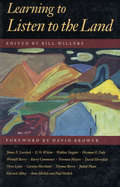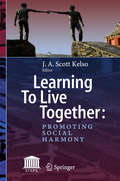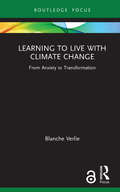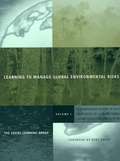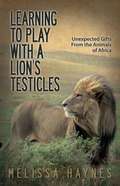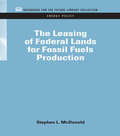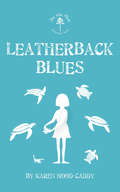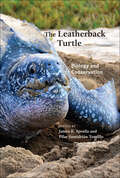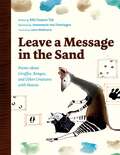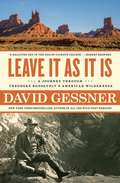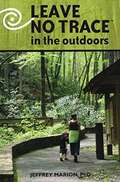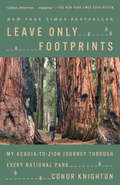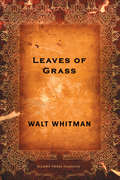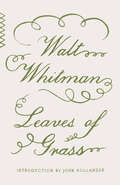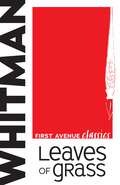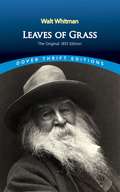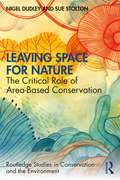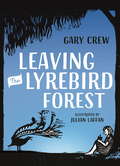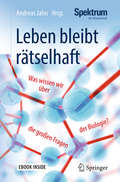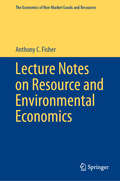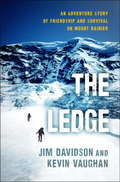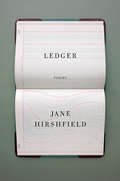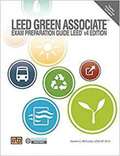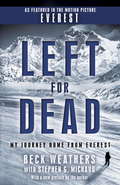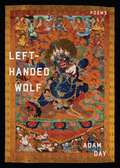- Table View
- List View
Learning to Listen to the Land
by William B. WillersIn this inspired collection, some of America's most provocative thinkers and writers reflect on nature and enviornmetnal science--reaching compelling conclusions about humanity's relationship to the earth. Balanced by science and fact,Learning to Listen to the Landexplains the significance of our modern environmental crisis. The authors underscore the necessity forworking within, rather than counter to, our larger ecosystem. Learning to Listen to the Land represents the sounding of an alarm. It's authors call on us to recognize the consequences of our actions, and inactions, and to develop a sense of connection with the earth.
Learning To Live Together: Promoting Social Harmony
by J. A. Scott KelsoThis book is devoted to the issue of how we can learn to live together in the face of division and conflict. It is dedicated to the life and work of a remarkable human being, Dr Epimenidis Haidemenakis, scientist, statesman, visionary leader, President Emeritus of the International S.T.E.P.S. Foundation and founding father of The Olympiads of the Mind (OM). The monograph consists of a collection of papers presented at the 8th and 9th Olympiads of the Mind held in Washington, DC and Chania, Crete respectively. Distinguished international scholars, government and corporate representatives, leading researchers and academics from multiple disciplines and Nobel Laureates Leon Lederman (Physics, 1988), Martin Perl (Physics, 1995) and Yuan T. Lee (Chemistry, 1986) address a broad range of issues all with the aim of improving the human condition and achieving cooperation among the people of the world. The topics include the environment, sustainability and security; diversity and how to achieve integration and peace among people in a fractured world; the important role of brain research; how to overcome poverty and inequality; how to enhance creativity and improve education at all levels; and how new technologies and tools can be used for common benefit. The culmination of the book is a call to action, to join what one might call the “OM Movement”—bringing the best minds in the world together to create solutions to world issues so that we can all live together in harmony.
Learning to Live with Climate Change: From Anxiety to Transformation (Routledge Focus on Environment and Sustainability)
by Blanche VerlieThis imaginative and empowering book explores the ways that our emotions entangle us with climate change and offers strategies for engaging with climate anxiety that can contribute to social transformation. Climate educator Blanche Verlie draws on feminist, more-than-human and affect theories to argue that people in high-carbon societies need to learn to ‘live-with’ climate change: to appreciate that human lives are interconnected with the climate, and to cultivate the emotional capacities needed to respond to the climate crisis. Learning to Live with Climate Change explores the cultural, interpersonal and sociological dimensions of ecological distress. The book engages with Australia’s 2019/2020 ‘Black Summer’ of bushfires and smoke, undergraduate students’ experiences of climate change, and contemporary activist movements such as the youth strikes for climate. Verlie outlines how we can collectively attune to, live with, and respond to the unsettling realities of climate collapse while counteracting domineering ideals of ‘climate control.’ This impressive and timely work is both deeply philosophical and immediately practical. Its accessible style and real-world relevance ensure it will be valued by those researching, studying and working in diverse fields such as sustainability education, climate communication, human geography, cultural studies, environmental sociology and eco-psychology, as well as the broader public.
Learning to Manage Global Environmental Risks
by Social Learning GroupThis book examines how ideas, interests, and institutions affect management practice; how management capabilities in other areas affect the ability to deal with environmental issues; and how learning affects society's approach to the global environment.
Learning to Play With a Lion's Testicles
by Melissa HaynesThe cheeky title of Melissa Haynes's story of adventure in Africa, Learning to Play with a Lion's Testicles, earned the book some big publicity on NBC-TV/Late Night with Jimmy Fallon on September 4,2013 where it topped the show's list of "Titles Not to Read" for September 2013. Melissa's book was also a big smash on the March 11, 2014 Ellen Show, where Ellen and guest Ricky Gervais highlighted the book throughout the entire hour. Playing with a lion's testicles: An African saying that means to take foolhardy chances.Melissa, an exhausted executive from the city seeks meaning and purpose from her work, and volunteers for a Big Five conservation project in South Africa. Her boss, an over-zealous ranger, nicknamed the Drill Sergeant, has no patience for city folk, especially if they're women, and tries to send her packing on day one. But Melissa stands her ground with grit and determination, however shaky it may be.Conflict soon sets the pace with a cast filled with predatory cats, violent elephants, and an on-going battle of wits with the Drill Sergeant. Even Mother Nature pounds the reserve with the worst storm in a century. But the most enduring and profound conflict is the internal battle going on within Melissa, as she tries to come to terms with the guilt surrounding her mother's death. When death grips the game reserve, it is the very animals Melissa has come to save that end up saving her.For the reader who has ever dreamed of going to Africa or knows the pain of loss and guilt, LEARNING TO PLAY WITH A LION'S TESTICLES will fill your soul.
The Leasing of Federal Lands for Fossil Fuels Production (RFF Energy Policy Set)
by Stephen MacdonaldStephen McDonald offers a basic understanding of the goals and practices by which the federal government leases its fossil fuel resources and how these practices affect the economy. Originally published in 1979
Leatherback Blues: The Wild Place Adventure Series (The\wild Place Adventure Ser. #4)
by Karen Hood-CaddyRobin is kidnapped by dangerous poachers while trying to save leatherback turtles in Central America. Robin Green is carrying on her work rescuing vulnerable animals at The Wild Place Animal Shelter when she and Zo-Zo get an amazing chance to help protect sea turtles in Central America. Worried about the bugs, the heat, and the threat of poachers, Robin faces her fears and travels there with Zo-Zo, her brother, Squirm, and her eccentric grandmother, Griff. It only takes one scorpion sting before Robin wants to go home, but the unbelievable sight of a leatherback turtle laying eggs on the beach changes her mind. Just when the group starts making progress, the poachers strike back. Suddenly, the turtles aren’t the only ones who need rescuing! Can Robin and Zo-Zo find a way out?
The Leatherback Turtle: Biology and Conservation
by James R. Spotila Pilar Santidrián TomilloThe most comprehensive book ever written on leatherback sea turtles.Weighing as much as 2,000 pounds and reaching lengths of over seven feet, leatherback turtles are the world’s largest reptile. These unusual sea turtles have a thick, pliable shell that helps them to withstand great depths—they can swim more than one thousand meters below the surface in search of food. And what food source sustains these goliaths? Their diet consists almost exclusively of jellyfish, a meal they crisscross the oceans to find. Leatherbacks have been declining in recent decades, and some predict they will be gone by the end of this century. Why? Because of two primary factors: human redevelopment of nesting beaches and commercial fishing. There are only twenty-nine index beaches in the world where these turtles nest, and there is immense pressure to develop most of them into homes or resorts. At the same time, longline and gill net fisheries continue to overwhelm waters frequented by leatherbacks. In The Leatherback Turtle, James R. Spotila and Pilar Santidrián Tomillo bring together the world’s leading experts to produce a volume that reveals the biology of the leatherback while putting a spotlight on the conservation problems and solutions related to the species. The book leaves us with options: embark on the conservation strategy laid out within its pages and save one of nature’s most splendid creations, or watch yet another magnificent species disappear.
Leave a Message in the Sand: Poems about Giraffes, Bongos, and Other Creatures with Hooves
by Bibi Dumon TakWhat would a boar text to a pig, a camel post on a dating site, or a goat shout from the mountaintops? In this unforgettable poetry collection, even-toed ungulates take the spotlight. Ever asked a giraffe about the clouds, read an okapi&’s letter to the editor, or debated which gnu would win the race across the Serengeti? Playful poems and whimsical illustrations feature hoofed creatures from all around the world, from Siberian musk deer to African dik-diks to South American vicuñas. Weaving together humor, scientific detail, and a poignant concern for conservation, Leave a Message in the Sand introduces readers to wild creatures with even wilder things to say.
Leave It As It Is: A Journey Through Theodore Roosevelt's American Wilderness
by David Gessner&“A rallying cry in the age of climate change.&” —Robert Redford An environmental clarion call, told through bestselling author David Gessner&’s wilderness road trip inspired by America&’s greatest conservationist, Theodore Roosevelt. &“Leave it as it is,&” Theodore Roosevelt announced while viewing the Grand Canyon for the first time. &“The ages have been at work on it and man can only mar it.&” Roosevelt&’s rallying cry signaled the beginning of an environmental fight that still wages today. To reconnect with the American wilderness and with the president who courageously protected it, acclaimed nature writer and New York Times bestselling author David Gessner embarks on a great American road trip guided by Roosevelt&’s crusading environmental legacy. Gessner travels to the Dakota badlands where Roosevelt awakened as a naturalist; to Yellowstone, Yosemite and the Grand Canyon where Roosevelt escaped during the grind of his reelection tour; and finally, to Bears Ears, Utah, a monument proposed by Native Tribes that is embroiled in a national conservation fight. Along the way, Gessner questions and reimagines Roosevelt&’s vision for today. As Gessner journeys through the grandeur of our public lands, he tells the story of Roosevelt&’s life as a pioneering conservationist, offering an arresting history, a powerful call to arms, and a profound meditation on our environmental future.
Leave No Trace in the Outdoors
by Jeffrey L. MarionThe essential guide for enjoying the outdoors without harming the environment. <p><p>• Details the seven core principles of Leave No Trace ethics and practices <p>• Covers hiking, campfires, food storage, and personal hygiene <p>• Endorsed by the USDI National Park Service, Bureau of Land Management, Fish and Wildlife Service, U.S. Geological Survey, and the USDA Forest Service
Leave Only Footprints: My Acadia-to-Zion Journey Through Every National Park
by Conor Knighton<P><P>From CBS Sunday Morning correspondent Conor Knighton, a behind-the-scenery look at his year traveling to each of America's National Parks, discovering the most beautiful places and most interesting people our country has to offerWhen Conor Knighton set off to explore America's "best idea," he worried the whole thing could end up being his worst idea. <P><P>A broken engagement and a broken heart had left him longing for a change of scenery, but the plan he'd cooked up in response had gone a bit overboard in that department: Over the course of a single year, Knighton would visit every national park in the country, from Acadia to Zion. In Leave Only Footprints, Knighton shares informative and entertaining dispatches from what turned out to be the road trip of a lifetime. Whether he's waking up early for a naked scrub in a historic bathhouse in Arkansas or staying up late to stargaze along our loneliest highway in Nevada, Knighton weaves together the type of stories you're not likely to find in any guidebook. <P><P>Through his unique lens, America the Beautiful becomes America the Captivating, the Hilarious, and the Inspiring. Along the way, he identifies the threads that tie these wildly different places together—and that tie us to nature—and reveals how his trip ended up changing his views on everything from God and love to politics and technology. Filled with fascinating tidbits about our parks' past and reflections on their fragile future, this book is both a celebration of and a passionate case for the natural wonders that all Americans share. <P><P><b>A New York Times Bestseller</b>
Leaves of Grass
by Walt WhitmanOriginally published as a collection of twelve poems in 1855, Leaves of Grass eventually grew to more than four hundred poems, as Walt Whitman continued to edit and add to the collection throughout his life.Celebrating life, humanity, and the material world, Leaves of Grass was considered obscene at the time of its publication because of its overt discussion of sensual pleasure. It is now considered to be among the greatest collections of poetry to be published in modern times.Be it mystery, romance, drama, comedy, politics, or history, great literature stands the test of time. ClassicJoe proudly brings literary classics to today's digital readers, connecting those who love to read with authors whose work continues to get people talking. Look for other fiction and non-fiction classics from ClassicJoe.
Leaves of Grass: Including A Fac-simile Autobiography, Variorum Readings Of The Poems And A Department Of Gathered Leaves... - Primary Source Edition (Vintage Classics #Vol. No. 9)
by Walt WhitmanAbraham Lincoln read it with approval, but Emily Dickinson described its bold language and themes as "disgraceful." Ralph Waldo Emerson found it "the most extraordinary piece of wit and wisdom that America has yet produced." Published at the author's expense on July 4, 1855, Leaves of Grass inaugurated a new voice and style into American letters and gave expression to an optimistic, bombastic vision that took the nation as its subject. Unlike many other editions of Leaves of Grass, which reproduce various short, early versions, this Modern Library Paperback Classics "Death-bed" edition presents everything Whitman wrote in its final form, and includes newly commissioned notes.
Leaves of Grass: 1st Edition 1855 (First Avenue Classics ™)
by Walt WhitmanIn Leaves of Grass, American poet Walt Whitman assembled most of his poetic works. Included in this collection are some of Whitman's most famous poems, including "Song of Myself," "I Sing the Body Electric," "Out of the Cradle Endlessly Rocking," and "O Captain! My Captain!" The first edition of Leaves of Grass was published in 1855 and contained only twelve poems. Whitman kept revising his collection throughout his life; the final edition contains more than three hundred poems. This is an unabridged version of the poems from the final edition of Whitman's celebrated collection, published shortly before his death in 1892.
Leaves of Grass: The Original 1855 Edition (Dover Thrift Editions: Poetry)
by Walt WhitmanIn 1855, Walt Whitman published — at his own expense — the first edition of Leaves of Grass, a visionary volume of twelve poems. Showing the influence of a uniquely American form of mysticism known as Transcendentalism, which eschewed the general society and culture of the time, the writing is distinguished by an explosively innovative free verse style and previously unmentionable subject matter. Exalting nature, celebrating the human body, and praising the senses and sexual love, the monumental work was condemned as "immoral." Whitman continued evolving Leaves of Grass despite the controversy, growing his influential work decades after its first appearance by adding new poems with each new printing. This edition presents the original twelve poems from Whitman's premier 1855 publication of Leaves of Grass. Included are some of the greatest poems of modern times: "Song of Myself," "I Sing the Body Electric," and "There Was a Child Went Forth" (which in the first editions of Leaves of Grass were still nameless), works that continue to upset conventional notions of beauty and originality even today.
Leaving Space for Nature: The Critical Role of Area-Based Conservation (Routledge Studies in Conservation and the Environment)
by Nigel Dudley Sue StoltonThis book provides the first contemporary assessment of area-based conservation and its implications for nature and society. Now covering 15 per cent of the land surface and a growing area of ocean, the creation of protected areas is one of the fastest conscious changes in land management in history. But this has come at a cost, including a backlash from human rights organisations about the social impacts of protected areas. At the same time, a range of new types of area-based conservation has emerged, based on indigenous people’s territories, local community lands and a new designation of “other effective area-based conservation measures”. This book provides a concise overview of the status and possible futures of area-based conservation. With many people calling for half the earth’s land surface to remain in a natural condition, this book taps into the urgent debate about the feasibility of such an aim and the ways in which such land might be managed. It provides a timely contribution by people who have been at the centre of the debate for the last twenty years. Building on the authors’ large personal knowledge, the book draws on global case studies where the authors have firsthand experience, including Yosemite National Park (USA), Blue Mountains National Park (Australia), Bwindi National Park (Uganda), Chingaza National Park (Colombia), Ustyart Plateau (Kazakhstan), Snowdonia National Park (Wales) and many more. This book is essential reading for students, academics and practitioners interested in conservation and its impact on society.
Leaving the Lyrebird Forest
by Gary Crew Julian Laffan'Are you lonely here?' her mother asked. 'Never,' Alice said. 'Not while I am friends with the lyrebird.'Alice has spent her life living on the outskirts of a small town, in a house nestled in bushland. Every other morning, she is visited by a lyrebird. Her bond with this magnificent bird brings her together with her nearest neighbour, Mr Brown, a widower who loves the bush and its treasures as much as she does.But change is coming: Alice is growing up, and having to think about her future (a future which might mean leaving the bush for her education). Mr Brown is getting older, and less able to look after himself. And as the nearby town grows, their beloved lyrebird and bushland are threatened too.A touching story that will resonate with readers everywhere, stunningly illustrated with woodcuts by acclaimed artist Julian Laffan.
Leben bleibt rätselhaft: Was wissen wir über die großen Fragen der Biologie?
by Andreas JahnDie ungeklärten Mysterien der BiologieWoher kommt das Leben? Warum schlafen wir? Wie können wir länger leben? Drei von sechs grundlegenden Fragen, die immer noch weitgehend offen sind und mit denen sich die moderne Biologie beschäftigt. Zu den ungelösten Mysterien zählen außerdem Evolution, Vererbung und Bewusstsein. Wie namhafte Wissenschaftler aus aller Welt versuchen, der Natur diese Geheimnisse Stück für Stück zu entlocken, beschreibt dieses Buch anhand ausgewählter Artikel aus den Zeitschriften "Spektrum der Wissenschaft" und "Gehirn&Geist". Meist sind es die Forscher selbst, die aus erster Hand ihre Beobachtungen und Entdeckungen schildern und somit Gelegenheit geben, ihnen über die Schulter zu schauen. Dabei sind sie sich längst nicht in allen Punkten einig. Der vorliegende Sammelband spiegelt den aktuellen Wissensstand, aber auch die zum Teil kontroversen Ansichten über die Wunder des Lebens wider.
Lecture Notes on Resource and Environmental Economics (The Economics of Non-Market Goods and Resources #16)
by Anthony C. FisherThis book, based on lectures on natural and environmental resource economics, offers a nontechnical exposition of the modern theory of sustainability in the presence of resource scarcity. It applies an alternative take on environmental economics, focusing on the economics of the natural environment, including development, computation, and potential empirical importance of the concept of option value, as opposed to the standard treatment of the economics of pollution control. The approach throughout is primarily conceptual and theoretical, though empirical estimation and results are sometimes noted. Mathematics, ranging from elementary calculus to more formal dynamic optimization, is used, especially in the early chapters on the optimal management of exhaustible and renewable resources, but results are always given an economic interpretation. Diagrams and numerical examples are also used extensively.The first chapter introduces the classical economists as the first resource economists, in their discussion of the implications of a limited natural resource base (agricultural land) for the evolution of the wider economy. A later chapter returns to the same concerns, along with others stimulated by the energy and environmental “crises” of the 1970s and beyond. One section considers alternative measures of resource scarcity and empirical findings on their behavior over time. Another introduces the modern concept of sustainability with an intuitive development of the analytics. A chapter on the dynamics of environmental management motivates the concept of option value, shows how to compute it, then demonstrates its importance in an illustrative empirical example. The closing chapter, on climate change, first projects future changes and potential catastrophic impacts, then discusses the policy relevance of both option value and discounting for the very long run.This book is intended for resource and environmental economists and can be read by interested graduate and advanced undergraduate students in the field as well.
The Ledge
by Jim Davidson Kevin Vaughan"My eyes travel up the frozen walls. I figure it is eighty feet up to the sunlight. The walls above me climb up at about eighty degrees, then they go dead vertical, and then, higher up, they overhang. It is as if I am looking out from the belly of a beast, its jagged white teeth interlocking above me." In June 1992, best friends Jim Davidson and Mike Price stood triumphantly atop Washington's Mount Rainier, celebrating what they hoped would be the first of many milestones in their lives as passionate young mountaineers. Instead, their conquest gave way to catastrophe when a cave-in plunged them deep inside a glacial crevasse--the pitch-black, ice-walled hell that every climber's nightmares are made of.An avid adventurer from an early age, Davidson was already a seasoned climber at the time of the Rainier ascent, fully aware of the risks and hopelessly in love with the challenge. But in the blur of a harrowing free fall, he suddenly found himself challenged by nature's grandeur at its most unforgiving. Trapped on a narrow, unstable frozen ledge, deep below daylight and high above a yawning chasm, he would desperately battle crumbling ice and snow that threatened to bury him alive, while struggling in vain to save his fatally injured companion. And finally, with little equipment, no partner, and rapidly dwindling hope, he would have to make a fateful choice--between the certainty of a slow, lonely death or the seeming impossibility of climbing for his life.At once a heart-stopping adventure story, a heartfelt memoir of friendship, and a stirring meditation on fleeting mortality and immutable nature, The Ledge chronicles one man's transforming odyssey from the dizzying heights of elation and awe to the punishing depths of grief and hard-won wisdom. This book's visceral, lyrical prose sings the praises of the physical world's wonders, while searching the souls of those willing, for better or worse, to fully embrace it.From the Hardcover edition.
Ledger: Poems
by Jane HirshfieldA pivotal book of personal, ecological, and political reckoning from the internationally renowned poet named "among the modern masters" (The Washington Post).Ledger's pages hold the most important and masterly work yet by Jane Hirshfield, one of our most celebrated contemporary poets. From the already much-quoted opening lines of despair and defiance ("Let them not say: we did not see it. / We saw"), Hirshfield's poems inscribe a registry, both personal and communal, of our present-day predicaments. They call us to deepened dimensions of thought, feeling, and action. They summon our responsibility to sustain one another and the earth while pondering, acutely and tenderly, the crises of refugees, justice, and climate. They consider "the minimum mass for a whale, for a language, an ice cap," recognize the intimacies of connection, and meditate upon doubt and contentment, a library book with previously dog-eared corners, the hunger for surprise, and the debt we owe this world's continuing beauty. Hirshfield's signature alloy of fact and imagination, clarity and mystery, inquiry, observation, and embodied emotion has created a book of indispensable poems, tuned toward issues of consequence to all who share this world's current and future fate.
LEED Green Associate Exam Preparation Guide (v4 Edition)
by Heather C. McCombs<p>The LEED Green Associate Exam Preparation Guide, LEED v4 Edition is designed to help you pass the LEED Green Associate exam. The exam prep guide captures the critical points you need to know about green building. It also reflects the structure of the exam knowledge and task domains to organize foundational concepts in green building and LEED. <p>The exam prep guide will help you prepare for the exam by emphasizing key terms and providing application learning through practice questions. This resource is intended to be used in conjunction with the exam primary references, including the LEED Core Concepts Guide. Access to a variety of digital resources that enhance learning is also included with this guide.</p>
Left for Dead: My Journey Home from Everest
by Beck WeathersI am neither churchly nor a particularly spiritual person, but I can tell you that some force within me rejected death at the last moment and then guided me, blind and stumbling--quite literally a dead man walking--into camp and the shaky start of my return to life. On May 10, 1996, nine climbers perished in a blizzard high on Mount Everest, the single deadliest day ever on the peak. The following day, one of those victims was given a second chance. His name was Beck Weathers.The tale of Dr. Seaborn Beck Weathers's miraculous awakening from a deep hypothermic coma was widely reported. But the hidden story of what led the pathologist to Everest in the first place, and his painful recovery after his dramatic rescue, has not been told until now. Brilliant and gregarious, Weathers discovered in his thirties that mountain climbing helped him cope with the black dog of depression that had shadowed him since college. But the self-prescribed therapy came at a steep cost: estrangement from his wife, Peach, and their two children. By the time he embarked for Everest, his home life had all but disintegrated. Yet when he was reported dead after lying exposed on the mountain for eighteen hours in subzero weather, it was Peach who orchestrated the daring rescue that brought her husband home. Only then, facing months of surgery and the loss of his hands, did Beck Weathers also begin to face himself, his family, his past and uncertain future. Told in Beck Weathers's inimitably direct and engaging voice--with frequent commentary from Peach, their family, their friends and others involved in this unique journey--Left for Dead shows how one man's drive to conquer the most daunting physical challenges ultimately forced him to confront greater challenges within himself. Framed by breathtaking accounts of his near death and resurrection, and of his slow and agonizing physical and emotional recovery, Left for Dead offers a fascinating look at the seductive danger of extreme sports, as in rapid succession a seemingly unstoppable Weathers attacks McKinley, Elbrus, Aconcagua, Kilimanjaro--before fate stops him cold, high in the Death Zone of the world's tallest peak. Full of deep insight and warm humor, Left for Dead tells the story of a man, a marriage and a family that survived the unsurvivable. Candid and uncompromising, it is a deeply compelling saga of crisis and change, and of the abiding power of love and family--a story few readers will soon forget.
Left-Handed Wolf: Poems
by Adam DayAdam Day’s Left-Handed Wolf offers short lyrical meditations and narratives that wrestle with contemporary issues of the environment, spirituality, and the social. These compact, imagistic poems welcome space and silence as a way of addressing both the commonality and complexity of people and experience. Day’s poems—influenced by meditation practice, as well as by classical Japanese and Chinese verse—are serious and bawdy, reverential and impertinent, accessible and eclectic, yet unified in their tone, atmosphere, and sensibility.
